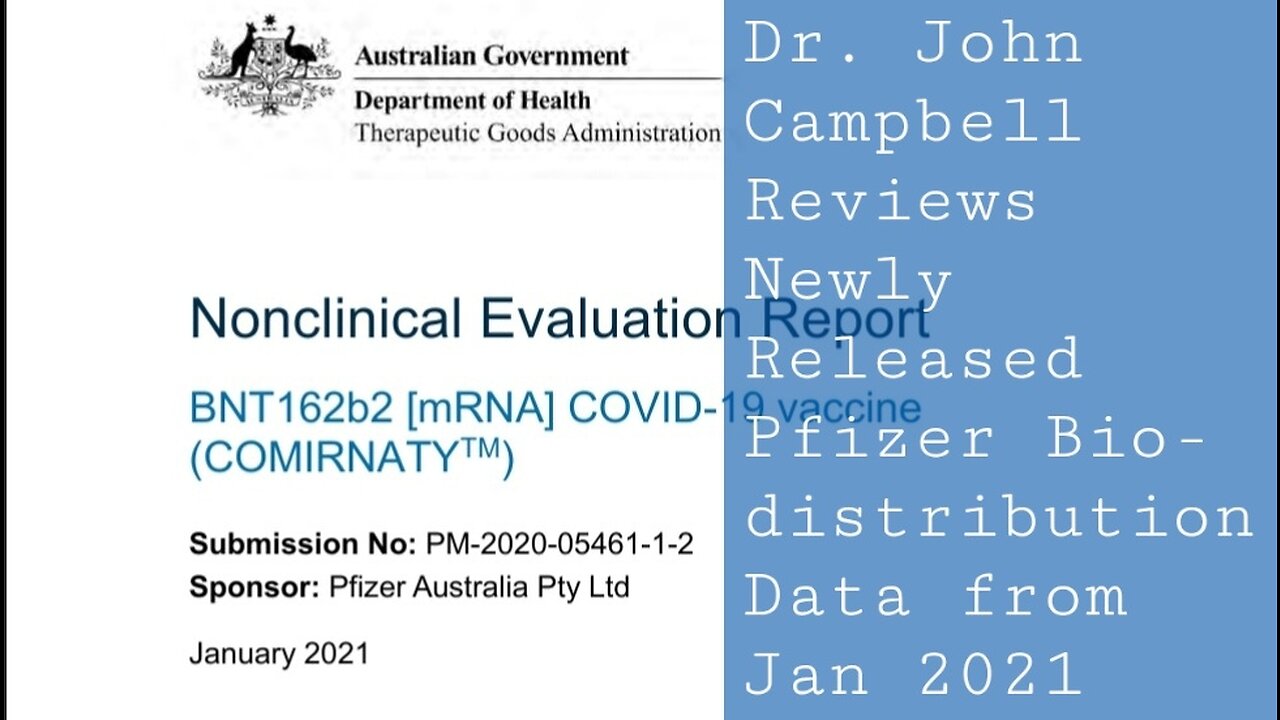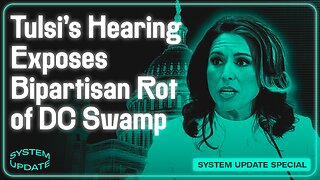Premium Only Content

Dr. John Campbell Reviews Newly Released Pfizer Biodistribution Data from Jan 2021
Dr. John Campbell Reviews Newly Released Pfizer Biodistribution Data from Jan 2021
"I think we can be certain this information was on Anthony Fauci's desk... Bear in mind all this was known before the vaccines were approved...I'm struggling for words."
SUMMARY
Pfizer Australia Pty Ltd has applied for provisional registration of a new mRNA vaccine, BNT162b2 [mRNA] COVID-19 vaccine (COMIRNATY), in lipid nanoparticle (LNP) formulation [BNT162b2 (V9)] indicated for active immunisation to prevent COVID-19 disease caused by
SARS-CoV-2 virus, in individuals 16 years of age and older. The proposed dosing regimen involved administering two doses of 30 μg of mRNA/0.3 mL per dose given 21 days apart intramuscularly (IM).
The sponsor has generally conducted adequate studies on pharmacology and toxicity (GLP compliant repeat dose and developmental and reproductive toxicity studies) with BNT162b2 (V9). Limited pharmacokinetic studies were conducted with the LNP formulation and two novel
lipid excipients (ALC-0159 and ALC-0315).
BNT162b2 (V9) was found to be immunogenic in non-clinical studies in mice, rats, and rhesus macaques. BNT162b2 (V9) induced humoral and cellular immune responses in mice and monkeys. However, antibodies and T cells in monkeys declined quickly after 5 weeks after the second dose of BNT162b2 (V9), raising long-term immunity concerns.
The vaccine protected monkeys from infection when challenged 55 days after the 2nd vaccine dose based on viral RNA load and radiographic lung lesions. The vaccine dose in monkeys (100 μg) was higher than the proposed clinical dose of 30 μg.
Almost similar microscopic lung inflammation was observed in both challenged control and immunised animals after the peak of infection (Days 7/8). Rhesus macaques do not show clinical signs and generally develop only mild lung pathology from SARS-CoV-2 infection. There were no studies on the protection of older animals from SARS-CoV-2 infection or duration of protection after immunisation. The animal studies were of short term; long-term immunity was not assessed. The sponsor indicated that long-term immunity would be addressed by human data.
There are no distribution and degradation data on the S antigen-encoding mRNA. A whole body imaging study with a surrogate, luciferase expressing mRNA, indicates that the vaccine LNP formulation is expected to deliver the mRNA effectively in vivo, the mRNA and translated antigen
protein are mainly localised at the injection site, distributed in liver and likely draining lymph nodes, and nearly completely degraded in 9 days.
The limited studies showed slow elimination of ALC-0315 and retention in the liver, and complete elimination of ALC-0159 in 14 days, with the latter eliminated in faeces most likely by biliary
excretion. Both lipids are also eliminated by amide or ester hydrolysis.
BNT162b2 (V9) was tolerated in rats without evidence of systemic toxicity. Rats administered BNT162b2 (V9) (3 IM doses once weekly at 30 μg/dose, ~200 times the clinical dose on a μg/kg basis) showed injection site inflammation, clinical pathology (increases in white blood cells,
basophils, eosinophils, neutrophils, large unstained cells, fibrinogen, and acute phase proteins), and tissue pathology(hypercellularity of draining lymph nodes, spleen and bone marrow),
consistent with immune stimulation and inflammation responses as well as minimal vacuolation of portal hepatocytes without evidence of liver injury. All effects were either partially or fully reversible after 3 weeks of recovery. However, the dosing interval (one week) was not ideal given
the immune response peaks 2-3 weeks after dosing, and the clinical dosing interval is 3 weeks. Given the availability of clinical data, another repeat dose study in animals is not considered necessary. The shortcoming of the repeat dose toxicity study design should not preclude
approval of the vaccine.
CONCLUSIONS AND RECOMMENDATION
Primary pharmacology studies indicate the vaccine elicits both neutralizing antibody and cellular immune responses to the spike (S) antigen in mice and monkeys, and conferred some protection of monkeys from infection.
Antibodies and T cells in monkeys declined quickly over 5 weeks after the second dose of BNT162b2 (V9), raising concerns over long term immunity, which will be assessed by clinical studies according to the Sponsor. Repeat dose toxicity studies with the proposed vaccine and a variant, both in the LNP formulation, in rats raised no safety issues. Findings were consistent with immune stimulation and inflammation responses (injection site inflammation, increased body temperature,
leucocytosis, increased large unstained cells, fibrinogen and acute phase proteins, and hypercellularity of lymphohaematopoietic tissues). Hepatocyte vacuolation (probably lipid
vacuoles) was not associated with evidence of liver injury and was reversible.
The toxicity of the LNP formulation and novel excipients ALC-0159 and ALC-0315 was assessed in one species as part of the repeat dose study with the vaccine. Neither the mRNA nor the lipid excipients of the LNP formulation are expected to have genotoxic potential. However, the
potential of the LNP or the vaccine formulation for complement activation or stimulation of cytokine release was not adequately assessed in nonclinical studies. Further investigation (i.e., analysis of complement activation and cytokine stimulation) is recommended unless this
particular concern is addressed by clinical data. The absence of a repeat dose toxicity study in a second species and genotoxicity studies with the novel excipients was adequately justified by the
Sponsor.
A combined reproductive and developmental study showed no adverse effects on female fertility, embryofetal development and post-natal development (up to weaning) in rats. Pregnancy category B1 is considered acceptable
Short term protection studies, lack of pharmacokinetic data for the S antigen-encoding mRNA (BNT162b2 V9), suboptimal dosing interval in the repeat dose study, lack of repeat dose toxicity
studies in a second species and genotoxicity studies with the novel excipients, and lack of studies
investigating potential for autoimmune diseases were noted. However, these deficiencies are either adequately justified by the Sponsor or addressable by clinical data.
There are no nonclinical objections to the provisional registration of the vaccine. Long term immunity, vaccine induced autoimmune diseases were not studied in the nonclinical program and should be addressed by clinical data post provisional registration. Nonclinical studies on
complement activation and stimulation of cytokine release are recommended unless these issues are addressed by clinical data.
The draft product information should be amended as directed on pages 15-16.
-
 2:52:22
2:52:22
Alex Zedra
10 hours agoLIVE! New Game | Infestation Origins
31.5K2 -
 1:01:25
1:01:25
Rob Braxman Tech
17 hours agoBusy Week in the AI World! What this Means for You!
71.8K20 -
 1:02:53
1:02:53
The Charlie Kirk Show
10 hours agoTHOUGHTCRIME Ep. 71 — Airline DEI Again! Fed Redditors? Gayest Movie Ever?
115K86 -
 1:57:34
1:57:34
Kim Iversen
14 hours agoRFK Jr., Tulsi, Kash Patel SHRED Senate Clowns—Democrats Humiliated!
138K282 -
 3:06:08
3:06:08
Laura Loomer
10 hours agoEP 97: Trump's Nominees Transform America
69.7K53 -
 1:03:00
1:03:00
Man in America
18 hours agoThe Helicopter Crash DOESN'T MAKE SENSE... What REALLY Happened???
64.3K122 -
 55:11
55:11
Flyover Conservatives
1 day agoParents WIN, Teachers Unions PANIC! 3 Huge Education Bombshells This Week! - Corey DeAngelis | FOC Show
96.4K8 -
 1:40:20
1:40:20
Glenn Greenwald
14 hours agoTulsi's Hearing Exposes Bipartisan Rot of DC Swamp | SYSTEM UPDATE #400
139K232 -
 1:19:48
1:19:48
Simply Bitcoin
19 hours ago $18.19 earnedJerome Powells MASSIVE Bitcoin Backflip! | EP 1172
99.8K6 -
 58:42
58:42
The StoneZONE with Roger Stone
11 hours agoLBJ + CIA + Mob + Texas Oil = JFK Murder | The StoneZONE w/ Roger Stone
76.9K29